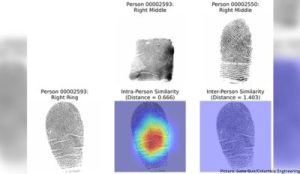In a serendipitous turn of events during the Covid-19 lockdowns, Gabe Guo, an undergraduate senior at Columbia University, found himself contemplating the uniqueness of fingerprints. This seemingly innocuous question sparked a three-year-long exploration that ultimately led to a paradigm-shifting study challenging the long-accepted belief that every fingerprint is distinct. Guo, along with his coauthor, Professor Wenyao Xu from the University of Buffalo, recently published their findings in the journal Science Advances, raising eyebrows and generating both excitement and skepticism within the forensic community.
The journey to these groundbreaking results involved overcoming numerous rejections from academic journals, with the forensics community initially pushing back against the unconventional findings. Guo, who had no prior background in forensics, noted the initial resistance: “For the first iteration or two of our paper, they said it’s a well-known fact that no two fingerprints are alike. I guess that really helped to improve our study because we just kept putting more data into it until eventually the evidence was incontrovertible.”
The study employed an artificial intelligence model called a deep contrastive network, commonly used for tasks such as facial recognition. Adding their unique twist, the researchers fed the AI system a US government database containing 60,000 pairs of fingerprints, some from the same person but different fingers and others from distinct individuals. The AI system, focused on angles and curvatures at the center of fingerprints, revealed surprising similarities between prints from different fingers of the same individual, challenging the established belief in fingerprint distinctiveness.
Guo explained the departure from traditional minutiae analysis, stating, “They are great for fingerprint matching, but not reliable for finding correlations among fingerprints from the same person.” The team acknowledged potential biases in their data, emphasizing the need for further validation across diverse demographics for the AI system to be considered reliable in actual forensic applications.
Despite skepticism from some experts, Guo expressed confidence in the potential impact on criminal investigations: “The most immediate application is it can help generate new leads for cold cases, where the fingerprints left at the crime scene are from different fingers than those on file.” He also highlighted the potential to spare innocent individuals from unnecessary investigations.

Notable forensic science professor Christophe Champod, while finding the use of deep learning on fingerprint images interesting, questioned the novelty of the study, stating, “Their argument that these shapes are somewhat correlated between fingers has been known from the early start of fingerprinting.” In response, Guo asserted that their study systematically quantified and utilized the similarities between fingerprints from different fingers to an unprecedented degree.
Simon Cole, a professor at the University of California, Irvine, echoed Champod’s sentiments, emphasizing that the unproven claim that no two fingerprints are ‘exactly alike’ remains intact. Cole questioned the practical utility of the study, particularly in cases where all ten fingerprints are routinely recorded during standard procedures.
The study authors, confident in their results, have open-sourced the AI code for public scrutiny. Guo sees the study’s significance extending beyond forensics, emphasizing the transformative role of AI in revealing hidden patterns: “This isn’t just about forensics, it’s about AI. Humans have been looking at fingerprints since we existed, but nobody ever noticed this similarity until we had our AI analyze it.”
The groundbreaking study challenges the conventional wisdom surrounding fingerprint uniqueness, offering potential implications for criminal investigations. The debate continues within the forensic community, with some experts praising the study’s novelty and others expressing skepticism about its practical applicability. Only time will tell whether this discovery proves to be a tempest in a teacup or a catalyst for reevaluating long-standing beliefs in the world of forensic science and artificial intelligence.
https://edition.cnn.com/2024/01/12/world/fingerprints-ai-based-study-scn/index.html
